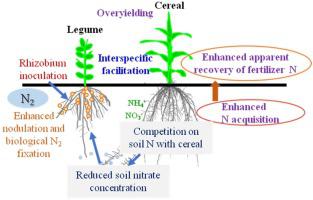Soil and Tillage Research ( IF 6.1 ) Pub Date : 2021-07-24 , DOI: 10.1016/j.still.2021.105154 Pei-Pei Mei 1, 2 , Ping Wang 3 , Hao Yang 1 , Lin-Guo Gui 4 , Peter Christie 1 , Long Li 1

|
Although intensive modern agriculture, featured with high inputs of chemicals, contributed to global food production, simultaneously caused a series of serious issues, such as loss of biodiversity, soil degradation, and environment risk. The objective of our study is to integrate various inherit biological potentials of cropping system to gain higher productivity with lower external inputs. Field experiments were conducted over a two-year period (2008-2009) with five fertilizer-N application rates (0, 75, 150, 225 and 300 kg N ha−1) to study the influence of fertilizer N application on the productivity and N utilization of a Rhizobium-inoculated maize (Zea mays L.)/faba bean (Vicia faba L.) intercropping system on a reclaimed desert soil (Sierozems). Average grain yields of faba bean and maize with inoculation increased by 50.0 and 19.6 %, respectively, and reached a maximum land equivalent ratio of 1.78 with zero fertilizer N application in 2009 compared with sole crops. The nodulation of intercropped faba bean was significantly higher with Rhizobium inoculation, especially with an optimum N application rate of < 150 kg N ha−1. Average %Ndfa and Ndfa increased by 42.5 and 86.6 %, respectively, based on interspecific interaction and inoculation. The average apparent N recovery of the intercropping system with inoculation increased by 146.5 % at 75 kg N ha−1 relative to the weighted mean values of sole crops. Intercropping saved fertilizer N compared to sole crops suggested by a fertilizer N equivalent ratio (NFER) > 1. Furthermore, intercropping with rhizobium inoculation saved more fertilizer N than that without rhizobium inoculation. After the faba bean harvest, intercropped maize made better use of the nitrogen taken up to grow faster than sole maize. At the maize harvest the intercropping system showed higher grain yield and N acquisition in the aboveground parts and lower Nmin accumulation in the soil profile, an effect that declined with fertilizer N application. The results therefore indicate that Rhizobium-inoculated maize/faba bean intercropping on the reclaimed desert soil with a moderate fertilizer N application rate enhancede productivity, biological N2 fixation and apparent N recovery with lower environmental risk.
中文翻译:

在开垦的沙漠土壤中间作根瘤菌接种的玉米/蚕豆可提高生产力和共生 N2 固定并减少明显的 N 损失
以高投入化学品为特征的集约化现代农业在为全球粮食生产做出贡献的同时,也引发了生物多样性丧失、土壤退化、环境风险等一系列严重问题。我们研究的目的是整合种植系统的各种遗传生物潜力,以较低的外部投入获得更高的生产力。在为期两年(2008-2009 年)的田间试验中,采用五种施氮量(0、75、150、225 和 300 kg N ha -1)研究施氮对生产力和接种根瘤菌的玉米 ( Zea mays L.)/蚕豆 ( Vicia faba ) 的氮利用L.) 开垦荒漠土壤上的间作系统 ( Sierozems )。与单一作物相比,2009 年零施氮肥的蚕豆和玉米平均籽粒产量分别增加了 50.0% 和 19.6%,达到了 1.78 的最大土地当量比。接种根瘤菌后,间作蚕豆的结瘤率显着提高,尤其是在最佳施氮量 < 150 kg N ha -1 的情况下。基于种间相互作用和接种,平均 %Ndfa 和 Ndfa 分别增加了 42.5% 和 86.6%。在 75 kg N ha -1 时,间作系统的平均表观氮回收率增加了 146.5 %相对于单一作物的加权平均值。与单一作物相比,间作氮肥当量比 (NFER) > 1 时节省了肥料 N。此外,间作接种根瘤菌比不接种根瘤菌节省了更多的氮肥。蚕豆收获后,间作玉米比单作玉米更好地利用了吸收的氮,使其生长得更快。在玉米收获期,间作系统表现出较高的谷物产量和地上部分的氮吸收量和较低的土壤剖面中的 Nmin 积累,这种影响随着施氮肥而下降。因此,结果表明根瘤菌-inoculated玉米/蚕豆间作对所述再生漠土具有中等氮肥施用量enhancede生产率,生物Ñ 2固定,并用较低的环境风险氮肥利用率。











































 京公网安备 11010802027423号
京公网安备 11010802027423号